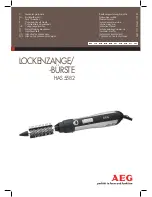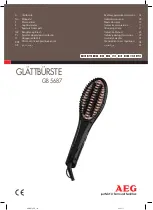
3
GENERAL INFORMATION
The aim of this service manual is to assist your technical departments in carrying out effective repair
work, and to provide first rate after sales service to your customers.
We recommend that you follow the instructions contained in this manual as they are in compliance
with the rules and regulations of electrical control authorities.
D
ISMANTLING
–
A
SSEMBLING
–
A
DJUSTING
Since the press seldom needs to be taken apart completely, components which are very simple or
which virtually never need to be replaced have not been included in this manual.
Please note that the threads in die-cast, pressure-injected plastic have been cut with self-tapping
screws. Therefore, when reassembling the press, it is necessary to make sure that the screws are put
into the same threading as before.
M
ALFUNCTIONS
The procedures in this manual have been drawn up to follow a logical sequence. In order to locate
and eliminate the source of a failure, carefully follow the explanations listed under the ‘Malfunctions’
heading in this manual.
M
AINTENANCE OF THE
H
EATING
S
HOE
The press needs very little lubrication, and the only maintenance required is to keep the heating shoe
clean.
During any ironing procedure, as with an ordinary hand iron, fabric finishes, residues from dry
cleaning chemicals, particles of thread and impurities in the water can gradually stain the heating
shoe. For these reasons, it is advisable, after ironing and/or whenever necessary, to rub the shoe
while it is still hot with a soft cloth that will not leave any threads or lint on the heating shoe. This care
is sufficient for normal use of the press on a regular basis.
However, from time to time, and/or after heavy use (for example, hot iron transfers, ironing synthetic
fabrics on high heat), it will be necessary to clean the heating shoe surface more thoroughly using a
cleaning product for hand irons (Elna part no. 802450-22).
To do so, first turn the press upside down so that the cleaning product applied to the shoe does not
drip onto the ironing board cover. It is important to heat the shoe well (see instruction manual for
details).
Do not use
alkaline
scouring products (such as oven cleaning products) as they will ruin the
aluminum. The same is true for abrasive products and steel wool pads.
After cleaning, the shoe can be given a protective film by applying a very thin layer of
protection
liquid
(803532-33) to the still hot surface with a lint-free cloth lightly soaked in this liquid. Leave the
press open for about 20 minutes, set at the maximum temperature. Switch off and let it cool down
before closing and storing.
L
OCKING THE PRESS
For a safety reason, it is very important that the press is
locked
when it is being handled or sent to a
customer.
M
AINS
L
EAD
Make sure that your customer is aware that the plug on the mains lead must be pushed firmly into the
socket of the press. It should be pushed in as far as it can go.



































